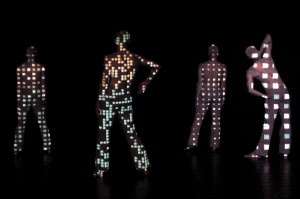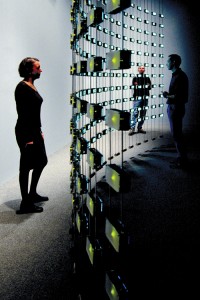The theme of this year’s Ars Electronica, Timeshift: The World in 25 Years, marked the 25th anniversary of the Ars Electronica festival.The thematic concept of Timeshift was to reflect upon the last 25 years of art, technology and society and to encourage dialogue and discussion about what the next 25 years might bring. A grand theme, that brought together a diverse range of artists,theorists, scientists, writers and cultural critics to ponder past, present and future trajectories.

Apparition, 2004. Concept and direction by Klaus Obermaier. Choreographed and performed by Desirée Kongerod, Robert Tannion. Image Source: Ars Electronica Centre
To accommodate this expansive topic, the 2004 Festival was slightly longer than in previous years. Comprised of a symposium, forums, live events and exhibitions these extra days allowed for a full and exhausting program. The first two days of the symposium were held in the central Festival venue, the Brucknerhaus, with four ½ day sessions focussing on
the themes: Progress, Disruption, Spirit and Topia. With only one session programmed at a time the symposium allowed for concentrated presentations and debate, with conference delegates granted the luxury of not having to choose between parallel sessions.
The Timeshift theme infused the structure of these sessions, with one young commentator adjudicating a discussion of four senior “pioneers”. In many ways this structure is typical of the Ars Electronica style, which is very much focussed on the voice and opinions of an older and established generation, with the younger generation providing a fresh slant on some well trodden ideas. However, what makes Ars Electronica an important and significant event and worth returning to, is the acknowledgement and inclusion of emerging practices within the main Festival Program.
Even though slightly marginalised outside of the academic and entrepreneurial focus of the symposium, sessions such as Language of Networks, Digital Commons, Collaborative Broadcasting and Digital Communities provide an insight and overview of emerging models of electronic art and media practices. These sessions present projects and initiatives that explore and develop new models for networking and communications as well as new ways of thinking around copyright, IP, education, international collaboration and so on.

Listening Post, 2004. Mark Hansen (USA) and Ben Rubin (USA). Image Source: Ars Electronica Centre
Ars Electronica also provides a unique opportunity to view and experience a range of recent international media art, interactive installations, net.art, sound projects and live performance. A highlight of the Festival and winner of the Golden Nica Interactive Art prize was the installation work Listening Post, by Ben Rubin and Mark Hansen. A highly enigmatic and hypnotic work, Listening Post comprises of filtered messages from chat rooms, displayed almost in real-time on 231 small electronic text displays and read aloud by a voice synthesiser. As intriguing as the installation itself, is the reaction of the audience who stand, sit or even lie in front of the ‘screen’ of text displays in a mesmerised euphoria.
Even though there was no Australian work in the main Cyberarts exhibition, it was encouraging to see a small exhibition of Australian media art included in the Ars Electronica program. Curated by Antoanetta Ivanova and Alessio Cavallaro and supported by the Australia Council. the Unnatural Selection exhibition comprised of works by Troy Innocent and Mari Velonaki (together with the Australian Centre for Field Robotics). An accompanying catalogue containing essays and profiles of several other artists was launched at the exhibition. It was also very pleasing to see a new installation performance work by Times Up, a Linz based group featuring ex-Australian artist and mathematician Tim Boykett. Sydney based new media artist Alex Davies also works with Times Up and assisted on this new work Sensory Circus - an arcade style interactive environment situated in the Ars Electronica Centre car park!
Overall Ars Electronica is a highly resourced and well-organised event that provides an overview of current directions in media art practice (with a particular focus on Europe, America and to an extent Canada and Japan). It is an insight into the strong networks that exist across the Euro-American media arts community and indeed the proliferation of labs and research centres for the development of media art practice. It certainly offers a challenge to Australia in terms of developing and strengthening our media arts culture and contributing to an international dialogue. Australian media artists have been major players in this international community over the last 25 years, however the resources currently available to Australian practitioners cannot match the development and support provided to our European and American collegues. As Ars Electronica looks at the world in 25 years, we in Australia need to look at and examine the present, our resources and education and indeed embrace and develop our networks in both the Asia Pacific region and across the highly activated European-North American media arts nexus.
Ars Electronica 2004 was held in Linz, Austria from 2 – 7 September 2004.
Julianne Pierce
Read More
http://www.aec.at/festival_about_en.php
http://www.exile.at/apparition/
Watch More
 This work is licensed under a Creative Commons Attribution-NonCommercial-ShareAlike 3.0 Australia.
This work is licensed under a Creative Commons Attribution-NonCommercial-ShareAlike 3.0 Australia.






